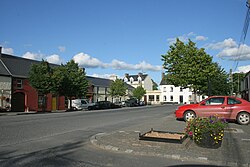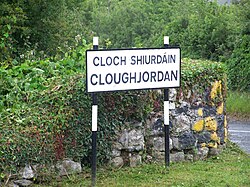Cloughjordan
| Cloughjordan Irish: Cloch Shiurdáin | |
| County Tipperary | |
|---|---|
 Cloughjordan village centre | |
| Location | |
| Grid reference: | R9761087713 |
| Location: | 52°56’25"N, 8°2’8"W |
| Data | |
| Post town: | Cloughjordan |
| Postcode: | E53 |
| Local Government | |
| Council: | Tipperary |

Cloughjordan is a town in the North Riding of County Tipperary. It is in the barony of Ormond Lower, and it is also a parish in the Roman Catholic Diocese of Killaloe.
The town is situated in the north-western part of Tipperary close to the border with County Offaly. It is almost equidistant from Nenagh, Roscrea and Birr and is close to Ireland's largest river, the Shannon, and Lough Derg.
Poet and patriot Thomas MacDonagh, a native of Cloughjordan, described it as a place "in calm of middle country".
Unusually for a town of its size (the 2002 Census Records places the population at 431), it has three churches – Roman Catholic (SS Michael and John's, built in 1898), Church of Ireland (St Kieran's, 1837) and Methodist (1875).
History
Developed at the intersection of travel routes between Nenagh, Birr, Borrisokane and Moneygall, the village of Cloughjordan began as an inhabited settlement during the Norman lordship of Ireland of the 13th and 14th centuries when the De Marisco family were allotted land in Ormond under the overlordship of the Butlers by King Henry II. One unit of the De Mariscos (Morris or Morrissey in modern terms) moved into this area, took over the territory and built a stone castle and manor house guarded by a moat surrounding the dwelling.
There is a story which relates that the first De Marisco, who resided here, was a Norman knight who had travelled to the Holy Land to take part in a Crusade against the Saracen invaders. He is said to have brought back a stone from the River Jordan which he built in over the doorway of this castle and it was from that stone that the village got its name – the Stone of Jordan – Clogh Shiúrdáin – Cloughjordan.
Cloughjordan was further developed in the late 17th century by Cromwellian grantees when Colonel John Harrison, an officer in Cromwell's army, was granted an estate of 1,484 acres of land around Cloughjordan in payment for his military services. Harrison built a house, now known as Cloughjordan House, at the site of the original Norman Castle of De Marisco and incorporated the old castle into the new building, in which one wall of the castle, about seven and a half feet thick, is still in existence to this day.
Cloughjordan was then remodelled in the late 18th century to include a square in front of the Church of Ireland on the east-west main street.
In 1909 Cloughjordan was one of the first villages in Ireland, after Carlow and Birr, to provide its own rural electrification scheme. The Electricity Supply Board took over the supplying of electricity to the town in 1948.
Transport
Cloughjordan railway station opened on 5 October 1863.[1] It is on the Limerick–Ballybrophy railway line, at Ballybrophy it joins the main Dublin-Cork railway line].[2]
Sport
- Kilruane MacDonagh's GAA is the local Gaelic Athletic Association club.
- Cloughjordan also has a association football club that competes in the North Tipperary & District League.
- Ormond Foxhounds are based at kennels in nearby Modreeny.
People
- Patrick Bergin, actor, resides in Cloughjordan.
- Dinny Cahill, former hurling player and manager born 1952 in Cloughjordan
- Fergus Costello, a liturgical artist and church designer who is an authority on Church art in Ireland and a stand-up comedian, is based in Cloughjordan.[3]
- Michael Joseph Costello, Army General, born 1904 in Cloughjordan.
- Len Gaynor, former hurling player and manager born 1944 in Cloughjordan.
- John MacDonagh, film director and playwright, brother of Joseph and Thomas MacDonagh (see below).
- Joseph MacDonagh, Sinn Féin politician, brother of John (see above) and Thomas (see below). Died whilst on hunger strike in 1922.
- Thomas MacDonagh, poet and patriot, born in Cloughjordan, was one of the signatories of the 1916 Proclamation of the Republic. He was executed in 1916 by firing squad. The local heritage centre and Gaelic Athletic Association park bear his name and a statue of him stands at the top of Main Street.[4]
- Tom Moloughney, former hurler, born 1940 in Cloughjordan.
- Éamonn O'Shea, former hurler and coach, born 1958 in Cloughjordan.
- Charlie Swan, multiple National Hunt Champion jockey.
- John Talbot, Canadian Reformer and schoolmaster, born 1797 in Cloughjordan.
Buildings of note
There are several buildings of architectural interest in and around Cloughjordan.[5][6][7]
- Cloughjordan House, Step Road. Oxpark (c. 1675) 17th-century house built on to existing tower house, further extended in the 18th century. A business consisting of a cookery school, wedding venue, event destination and B & B accommodation operates from here.[8]
- Mullenkeagh House, Borrisokane Rd. Detached two-storey house, renovated early 19th century in Georgian style but still contains many of its original features. (originally c. 1700, remodelled c. 1800)[9]
- Former Steward's house, Step Rd/Moneygall Rd. (c. 1770)
- Milestone, Main St/Moneygall Rd. (c. 1780)
- Bridge at Modreeny, Modreeny Estate (c. 1790) Cast iron parapets between cut limestone piers surmounted at one end by eagles, at the other by urns.
- Houses, formerly The Barracks (also known as the Militia Houses),[10] The Square (c. 1800) Built as a three storey barracks and later converted to housing. Original outbuildings to rear. The Meadow (or Square) was planned as an adjoining parade ground.
- Former Mill, Step Rd. (c. 1800)
- Distillery Cottage, Borrisokane Rd. Mullenkeagh. Single storey cottage built for the manager of the adjacent though now ruined, distillery. (c. 1820)[11]
- St Kieran's Church of Ireland church, The Square (1837) Designed by James and George Richard Pain for the Board of First Fruits. A cut stone spire surmounts the centrally placed entrance on to the Meadow (or Square).
- The Old Presbytery, Borrisokane Rd. (c. 1830)
- Former Hotel, Main St. (c. 1855)
- Cloughjordan railway station, Townfields Townland (1863) Cluster of structures, the classically influenced station building, station masters house and road bridge over the tracks.
- Cloughjordan Methodist Church, Main St. (1875) Modest church building with polychromic tiling.
- SS Michael and John's Roman Catholic Church, Moneygall Rd. (c. 1898) See stained glass windows from the studio of Harry Clarke, behind the altar, and Evie Hone, to the side of the altar.
- Modreeny House, Eminiska (c. 1920) Home built c 1920 in Arts and Crafts style to replace previous 18th-century house.
- Former Bank, Step Rd. (c. 1925)
- Various houses and former shops, Main St. (c. 1820–1900)
Festivals
Cloughjordan Festival is an annual celebration of art, sport, music and food held each summer in various venues around the village.[12][13]
Cloughtoberfest, a celebration of both Gypsy Jazz and Irish craft brewing took place each October from 2011 to 2015.
A Thomas MacDonagh Week-end was held in May 2014, one year after the opening of the Thomas MacDonagh Heritage Centre. It is hoped that this celebration of Cloughjordan's connection with MacDonagh will become an annual event.[14]
Awards
In 2012, 2013 and 2014 Cloughjordan won the National Green Community Award.[15]
References
- ↑ "Cloughjordan station". Railscot – Irish Railways. http://www.railscot.co.uk/Ireland/Irish_railways.pdf. Retrieved 7 September 2007.
- ↑ http://new.irishrail.ie/media/DublinLimerickviaNenagh111.pdf
- ↑ http://tipptatler.ie/2011/12/champion-comic-entertainer-fergus-costello-in-cloughjordan-festival-benefit/
- ↑ http://www.irishtimes.com/culture/heritage/cloughjordan-remembers-thoughtful-thomas-macdonagh-1.2633517
- ↑ An Introduction to the Architectural Heritage of North Tipperary, ISBN 0-7557-7444-2
- ↑ National Inventory of Architectural Heritage website
- ↑ L M. Mounsey (2008), "The Evolution and Architecture of Cloughjordan 1841 to 1901" thesis available for reference in Cloughjordan library
- ↑ http://www.cloughjordanhouse.com/
- ↑ http://www.buildingsofireland.ie/niah/search.jsp?type=record&county=TN®no=22304002
- ↑ http://www.cloughjordan.ie
- ↑ http://www.buildingsofireland.ie/niah/search.jsp?type=record&county=TN®no=22304001
- ↑ http://www.tipperarystar.ie/lifestyle/entertainment/cloughjordan-festival-launches-2012-programme-with-barbeque-and-raffle-1-3891840
- ↑ http://www.discoverireland.com/us/ireland-things-to-see-and-do/whats-on/listings/?fid=FI_73089
- ↑ http://www.macdonaghheritage.ie/dates-for-macdonagh-weekend-announced/
- ↑ Nenagh Guardian 26 April, page 7